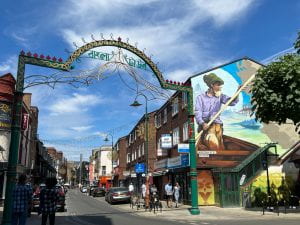Brick Lane has been known as the safe place for migrants for centuries. The earliest migrants included the French as well as Jewish people who were fleeing religious persecution in Catholic France in the 1570s. Bangladeshi, more specifically Sylheti seafarers came to Brick Lane as early as the 1600s by the way of the East India Company and imperial trading routes. There has been a thriving Bengali community in Brick Lane ever since.s Later, following Partition in 1947, when the Indian subcontinent became free from British rule and split into East and West Pakistan, and India, there was an influx of Sylheti immigrants due to the violent nature of the split. Partition later became known as the bloodiest human displacements in modern history. Similarly, there was another wave of immigrants that came into Brick Lane after the Bangladeshi Liberation War in 1971 where East Pakistan got their independence from West Pakistan and became known as Bangladesh.
This long history feels common place in England considering that many of the places I have visited on my trip here have been older than the country I come from. I find myself reevaluating my sense of time and relating to the statement that “a hundred miles is a large distance for a European while a hundred years is a long time for an American.” There is a sense of pride and sentimentality when it comes to these old historical places and a push towards preservation.
But what unfortunately sets Brick Lane apart from a lot of the other historical places I have visited is how despite its 400-year history tied to the Bangladeshi community, there is not as much recognition or motivation to preserve the sites. Many of the historical sites we visited seemed like normal buildings one could easily pass by without a second thought. There were also historical sites that were no longer there or were replaced by other establishments. But the issue that is affecting this community the most is the gentrification of the area with more upper middleclass people moving in and raising the rent prices to where the original people that have lived there for generations get displaced because they can no longer afford to live there anymore. As a result, many of the small Bangladeshi owned business, including the restaurants that Brick Lane is most famous for, are going out of business.
One of the main things that I caught myself thinking about during this study abroad trip is who’s narratives get prioritized. Signs of empire and Indian history are all around the UK if you know where to look and what to look out for. Sometimes it’s the one painting of a Mughal king talking to a member of the East India company in the corner of Parliament. Other times it is what is left unsaid about the legacy of colonialism in a tour. But this trip to Brick Lane compelled me to reflect on whose stories gets preserved and recognized over time and how power relates to that. And I think that’s something that is important to think about when seeking out sites to visit on a trip to avoid overlooking underrated places with rich culture and history.


